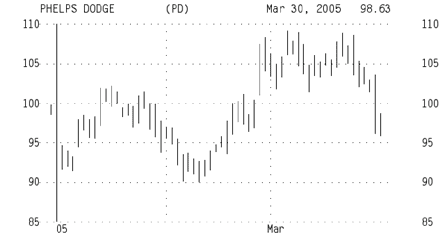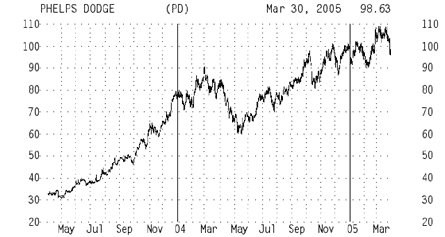| As of March 31, 2005 | ||
| Index | YTD % Change | Market Value |
| Dow Jones Industrials | – 2.6% | 10,503.8 |
| S&P 500 | – 2.6% | 1,180.59 |
| Nasdaq Composite | – 8.1% | 1,999.23 |
The following are important characteristics that are likely to continue over the course of 2005 and beyond unless the underlying economic dynamics change.
With a supply/demand cost squeeze feeding through the system, prices of semi-finished goods, excluding food and energy are rising at an annual rate of more than 8% – the most in 20 years. With the dollar falling, the cost of imported goods is rising allowing U.S. manufacturers to raise their prices. Moreover we expect to see higher energy prices add to this in the next two months. In the meantime the Fed has become more sensitive to signs of inflation, and we expect at a minimum a shift in language at the next Federal Reserve Board meeting which would lay the groundwork for more aggressive interest rate increases if it becomes necessary to deal with increasing inflation pressures.
Under these circumstances investors must continue to focus on the preservation of their buying power.
The current account deficit has been expanding since the mid-1990s, and for years economists and currency traders have been warning that it cannot continue to do so indefinitely. What can’t continue has to end; the only question is how and when.
One of our focuses has been in basic materials – iron ore, coal, steel, oil and gas, copper, and nickel. During the quarter the price of iron ore was raised by 71½%, and the price of iron ore pellets was increased by 86% by Cleveland-Cliffs. Now steel prices either will have to be raised or the steel industry must absorb higher costs. Iron ore and iron ore pellet costs are 10% of the cost of producing steel. Another example of a basic material in short supply is copper whose global inventories have been drawn down to 3-weeks of supply. As for energy prices, oil prices continued to rise as refineries operated at capacity while demand for oil products (i.e. gasoline and diesel) has kept increasing. The tightness in the energy market partly results from a lack of refinery capacity that will be with us for a considerable period of time.
We believe that world demand for raw materials will continue to remain strong and barring a global recession, we expect continuing industrial expansion. Congested highways, overflowing sewers and corroding bridges are a constant reminder to Americans of our neglected needs. We expect demand for basic materials that are needed for the growth of the global economy to continue to rise throughout the decade. Some of the companies benefiting from global industrialization sell at cash flow and earnings multiples of less than 5 times and 10 times respectively, and are in a position to raise their dividends significantly.
The U.S. faces numerous military challenges on a global scale. The challenge extends well beyond just Iraq and the Middle East. Top U.S. military commanders have warned Congress that China’s military power is growing at a rate much faster than China would seem to need for national defense. The growth has come particularly in the areas of maritime strength and aircraft attack capability.
Unlike mutual funds, hedge funds are basically unregulated. They are able to borrow securities and sell short, and they typically use significant leverage in their operations. Hedge fund trading tends to distort and force the prices of individual securities away from otherwise fundamental valuation considerations. The infrastructure, heavy industry, manufacturing, energy and basic materials sectors delivered a significant amount of the equity appreciation to portfolios during the quarter and had become a tempting target for hedge funds to sell and lock in profits as the quarter ended.
Over the past decade hedge funds have been the fastest growing component of the investment management community now representing over $1 trillion of investment capital. They also represent the lion’s share of daily trading volume on and off the exchanges. Hedge fund strategies are to generate positive rates of return and they are practiced on a daily basis. The goal is to garner near-term performance and lock in gains. Many are motivated by rumors and misperceptions as well as fundamental developments.
Hedge funds generate lucrative fee-based revenues for Wall Street through complicated trading strategies, creative financing deals and active trading, a major function of prime brokers. It is in the prime brokers’ interests to generate as much activity as possible which can add to volatility. It is estimated that hedge funds currently generate more than 30% of the Street’s equity commissions, and we expect that percentage to grow over the next several years. Hedge funds have become the focal point for profitability for prime brokers.
As an example of pronounced volatility, if one were to have owned Phelps Dodge through the first quarter of this year, the value of the holding would have fluctuated over 21% within that period…

If an investor with a buy and hold strategy disregarded the trading volatility that was in excess of 33% on the down side and held the stock for the past 2 years, the total return would have been in excess of 160%…

Volatility is a feature of today’s market. And while it can be uncomfortable for an investor to experience, it should not influence ones’ long-term investment discipline. However volatility does give investors the opportunity to purchase securities at more attractive prices when shares are undervalued.
Finally, our view of the outlook supports investment in selective dividend-paying equities and fixed income securities with maturities under 5 years.
Sign up to receive The Outlook — our timely newsletter featuring our investment and economic thinking — and highlights from our latest market insights will be emailed directly to your inbox.

